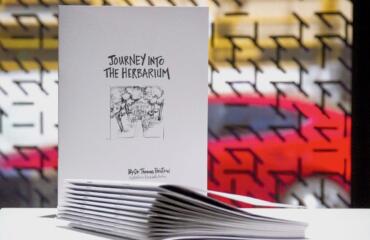
The 13th century missal, in which the flea was found. PIC: Maria Abbatangelo

The nigh-invisible insect had been trapped between the 800-year-old vellum pages of a Franciscan missal, or liturgical book, which had facilitated its journey through the centuries and, ultimately, across hemispheres.
The flea was among a cast of fellow time travellers — bugs, silverfish, spiders, fibres and debris — inside the folds of the Missal Codex Sancti Paschalis and destined for a 21st century reveal.

“When I had to go through and brush out each opening . . . it was fascinating,” said Ms Ben.
With great care, she removed, kept and catalogued each item, and got on with the job of conserving the work of stunning beauty, with its rounded gothic script and references to the diocese of Perugia, Italy, where it had originated.
But a few years ago, Ms Ben heard entomologist Ken Walker speak and it struck her that he could be interested in the flea. It proved to be a fortuitous cross-disciplinary moment that would provide further evidence linking the specimen to medieval Italy.

He was “fascinated”, she recalled.
Dr Walker, curator of entomology and arachnology with Museum Australia, sent colleague Peter Lillywhite and photographer Lucinda Gibson to inspect the tiny traveller.
High-resolution photography helped identify the stowaway as Xenopsylla cheopis, “an oriental rat flea”, according to Dr Anna Welch, a book historian at the State Library. “[T]he kind that brought the plague from China to Europe in the 1340s,” she told The Citizen.
“Definitely the book is in the right place for a plague flea to get into it because the plague really grew out of the port cities of Italy in the 1340s . . . and this book was in Italy in that period.”
But she cautioned: “We don’t know that it’s actually a medieval flea . . . It’s not . . . conclusive evidence.”
The decorative markers, pigments, silver and gold leaf used in the book’s images were “distinctively from Perugia”, the capital of the region of Umbria.
“[P]art of studying a manuscript like this is trying to identify when it was made, where it was made, and the decorative style can be really important in helping you understand [that],” Dr Welch told an audience this week at the State Library.

According to Dr Welch, the missal was made around 1290 and 500 years later ended up on the inventory of a Rome bookseller.
Another century on, in 1948, it came into the possession of Englishman Sir Thomas Phillipps, who was something of an obsessive collector of vellum books.
“[H]e had over 60,000 manuscripts in his collection, so many that his own family were sort of forced to move out of their enormous mansion because there wasn’t enough room for them and the books,” Dr Welch continued.
“Consequently, on his death, he left instructions that the library be kept together.
“But . . . his family immediately began to sell it off – in order to take revenge on him, presumably.”

In 1949, bookseller W.H. Robinson, also based in London, bought the Franciscan missal and other manuscripts.
But financial constraints in post-war Europe prompted Robinson to arrange for the State Library to exhibit manuscripts here in the hope that an Australian philanthropist would buy them for posterity.
“[While] the manuscript was on display . . . the Franciscan friars here in Melbourne saw it and wanted to own it again because, of course, it’s a really important part of their spiritual heritage.”
This apparently sparked a bidding war between the library and the friars and divided Catholic Melbourne over whom it should support.
“Ultimately, the library stepped back . . . on condition that if [the friars] ever wanted to sell it, the library would have first right of refusal.”
In keeping with the agreement, the missal was handed to the State Library in 1993 on long-term loan “for reasons of conservation”, Dr Welch said.
And with it came Xenopsyllus cheopis, awaiting discovery by the meticulous Ms Ben, who found it ensconced between two folios of the book.
That twice as much debris was found in the book’s spiritual centre — where there is an image of the crucifixion of Christ and the “Te Igitur”, the first words of the canon of the Mass — compared to any of the other openings was significant, Dr Welch suggested. This confirmed “the importance of the image, the centrality of this Mass, and that it would have been open to this page for long periods on the lectern, in the church.”
That collaboration between the library’s Ms Ben and Dr Welch was retold in this week’s public discussion, titled “One object, many stories: Medieval Flea”.

Dr Welch reflected that working with the conservator had enabled her “to learn as much from the material clues, that tell us more than sometimes we can tell just from what’s written in the book.”
While further testing of the flea to determine its origin more precisely could be destructive, Dr Welch wondered: “One day we may know.”
Asked for his thoughts on the flea, Father Joe McKay, of the Box Hill Franciscan Friary, cited a saying among the friars that “everything speaks”.
He said the flea was a reminder of history, the Black Death, the fragility of life and the challenge to assess what was really important.
“[I]t’s a reminder that we are mortal, we will die.”
Ironic, then, that Xenopsylla cheopis, safely ensconced in its Italian vellum home, travelled continents and through time to the Antipodes and a spot in the State Library limelight, gaining with it a hint of immortality.
► The missal, The Codex Sancti Paschalis, is on display at the State Library Victoria until October.



